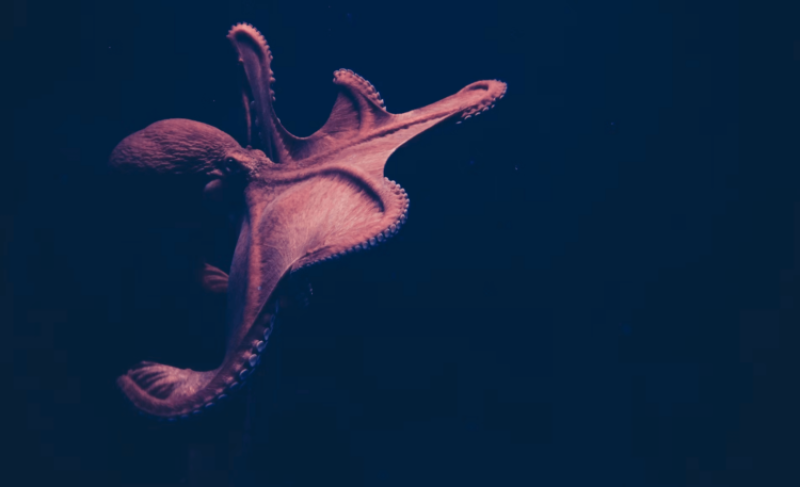Sometimes, we discover new ways that organisms do things. Changing gene expression – the set of genes that are transcribed into mRNA and then translated into proteins under a particular circumstance – is how organisms rapidly respond to a challenge. For an octopus, that might be a sudden plunge in water temperature, which slows enzyme activity.
But some species control genetic responses another way – via RNA editing. Changes in one of the four types of nitrogenous bases of an mRNA alter the encoded protein in ways that alter the protein’s function.
In a new report in Cell, Joshua Rosenthal of the Marine Biological Laboratory at Woods’ Hole and Eli Eisenberg at Tel Aviv University describe how the cephalopods – octopi, squid, and cuttlefish – change mRNAs in ways that alter enzymes. Because the edits are in RNA, and not DNA, they are fleeting. “We’re used to thinking all living things are preprogrammed from birth with a certain set of instructions. The idea the environment can influence that genetic information, as we’ve shown in cephalopods, is a new concept,” said Rosenthal.
In 2015, the researchers discovered that about 60 percent of the mRNAs in the common squid Doryteuthis pealeii are edited. The squid is a classic model organism for nervous system studies. The new study reveals the phenomenon in the California two-spot octopus.
When “gene editing” makes headlines, it’s typically in the context of using CRISPR and other DNA-cutting enzymes. In the cephalopods, it’s different. An adenine (A) in mRNA is replaced with an inosine, a base that interacts with others as if it is instead a guanine (G). This “A-to-I RNA editing” can introduce a single-base mutation, but an ephemeral one because it is in RNA. And if it occurs in a protein in a way that alters its function, the change affects the phenotype – such as altered enzyme activity that enhances survival under trying conditions.
Although A-to-I editing occurs in the genomes of most animal species, in the cephalopods, it is especially focused on protein-encoding genes. “A big question for us was, ‘What are they using it for?’” Rosenthal posed.
Perhaps RNA editing lies behind some aspects of the cephalopods’ complex behaviors. Because RNA is short-lived and the edits do not persist, the investigators looked to a temporary response, acclimatization to a changing environment – temperature. That matters because it governs the activity of enzymes, which in turn drive chemical reactions crucial to all physiological processes.
Like other cephalopods, the California two-spot octopus (Octopus bimaculoides) they studied cannot generate its own body heat to counteract the temperature drops that accompany tides, changes in water depth, and seasons.
The team observed responses in octopi in tanks at the Marine Biological Lab as well as in animals collected from octopus dens in the wild. When living in cold water tanks (13 degrees C/55 degrees F), the animals showed an increase in 13,285 mRNAs where the gene edits alter the encoded proteins’ functions. This might actually be an underestimate, the researchers write, because they focused on known sites of RNA editing that affect the complex nervous system. But when the octopi were moved to warm tanks (22 degrees C/72 degrees F), the number of edited RNA transcripts plummeted to just 550.
To complement the lab work, Matthew Birk, now at Saint Francis University in Pennsylvania, recorded temperatures near octopus dens in winter and late summer, then collected the animals and catalogued their RNA edits. Results from lab and nature agreed.
The gene edits affect the nervous system, which makes sense given the repertoire of complex behaviors for which the octopus is famous. My Octopus Teacher, a documentary film from 2020, illustrated the animal’s brain power in the true tale of Craig Foster, who followed and bonded with an octopus in a cold kelp forest near Cape Town. Foster trailed the young cephalopod for a year, who was clearly at ease with her human friend, providing an unprecedented view of how she lives.
The researchers and colleagues scrutinized two examples of RNA editing overseeing nervous system function. Specifically, they discovered a strong effect on two such proteins.
RNA editing speeds the action of kinesin-1, a protein that affects axonal transport – ferrying molecules along the main outgrowths of a neuron. A one-base RNA edit also alters responsiveness of synaptotagmin, which fosters neuron-to-neuron communication. The changes likely happen with gradual temperature shifts, the researchers write.
Rosenthal suspects that RNA editing in these two proteins is just “the tip of the iceberg,” and is likely behind the cephalopod’s superior brains that can oversee spectacular and sudden camouflage, communicate, and even solve puzzles.
The discovery and description of the elegant RNA editing of the octopus provides a compelling example of the fallacy of the widely-held idea of “scientific proof.” The beauty of science, to me, is that new evidence continually alters what we thought we knew.
Ricki Lewis has a PhD in genetics and is a science writer and author of several human genetics books. She is an adjunct professor for the Alden March Bioethics Institute at Albany Medical College. Follow her at her website or X @rickilewis
A version of this article was originally posted at PLOS and has been reposted here with permission. Any reposting should credit the original author and provide links to both the GLP and the original article. Find PLOS on X @PLOS
































